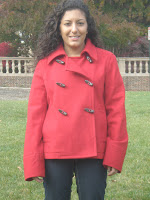Thursday, November 20, 2008
The three most imortant rules for a journalist to follow
Monday, November 17, 2008
Towson's efforts to go green
Friday, November 7, 2008
What audio can add to a story
Monday, November 3, 2008
Picture Time: Mugshots and More


 Towson students embrace the fall winds while walking through campus.
Towson students embrace the fall winds while walking through campus.
As a journalist, it is important to be able to take your own pictures and take them well. One way to take better pictures is to check for the right lighting, you don't want it to be too bright or so dark that you can't see the object in the picture. To make sure your lighting is right, you can use your hand and circle around to check where the light is best. Also, be sure there are no objects, such as trees in the background that look like they are sticking out of some one's head. Another way to take a better picture is to fill the frame; get in close. This way the viewer has a better understanding and appreciation of your scale. Finally, try to catch expected events or use alternate angles to make a shot more interesting.
Thursday, October 30, 2008
"Storytime Spooktacular": Multimedia Story #1
Tuesday, October 14, 2008
Baltimore hopefully about to expereince the single largest homocide decrease since 1970

Tuesday, September 30, 2008
Inverted Pyramid: What it looks in the news

Tuesday, September 23, 2008
Covering my first story!
http://www.towson.edu/applications/dailydigest/databases/news/20080911_033810PM_roconnel_91.asp
Thursday, September 18, 2008
Twiitter Headlines!
http://twitter.com/thecarrie
Tuesday, September 16, 2008
Finding a story: Press Release vs. Orginal Reporting

Thursday, September 11, 2008
Short Reports and Summary Ledes!
http://www.nytimes.com/pages/todayspaper/index.html
Summary Ledes, similar to short reports, are the opening of a news story and quickly summarize the story. However, unlike short reports, a summary lead has a time element and is in the past tense. Take a look at this one in The Baltimore Sun: "Law enforcement officials today arrested nine people after 18 federal raids that netted heroin, automatic weapons and bags of cash. It was the second major takedown in two days. On Wednesday, officers raided a West Baltimore home and seized seven kilos of heroin, $200,000 in cash and automatic weapons.". It has a time element, "today"(September 11, 2008) and is written in the past tense as you can see by "arrested", "raided", "seized", etc.
http://www.baltimoresun.com/
Monday, September 8, 2008
Blog #3: Front Page News from the Baltimore Sun
Another newsworthy story on the front page of The Sun is about the most recent slot coverage "Columbia Democrats to hold forum on slots". This story is newsworthy because in November Maryland residents will vote on whether or not slots to allow slot machine in their state, displaying the traditional news value of timeliness. As well this story is part of The Sun's ongoing coverage on slots which is currency, a direct tie to stories already in the news. Also, the news value of impact, specifically potential meaning things that happen as a consequence of an event, if Maryland vote in favor of slots, slot machines will become legal.
The third story is "Bay Bridge repairs complete". First and foremost, this story is newsworthy due to its impact on the Sun's audience. Since August 26th, round the clock lane inspects occurred to repair corrosion found in the bolts that anchor concrete barriers to the deck of the bridge, closing down the eastbound lane. This impacted not only the many commuters who use the bridge but especially Eastern Shore residents who were sometimes stuck on the bridge for an hour and a half! Timeliness also makes this story newsworthy since it was just announced today that lane closing will only be from 10 pm to 5am instead of round the clock, a relief for many Bay Bridge commuters. Also, the traditional news value of currency makes this story newsworthy since this story ties into the previous story of ordered emergency repairs on the bridge.